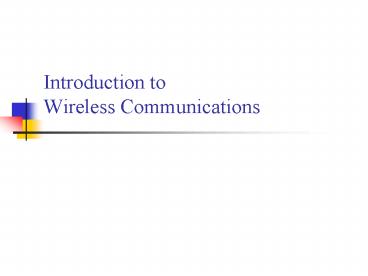Introduction to Wireless Communications - PowerPoint PPT Presentation
1 / 30
Title:
Introduction to Wireless Communications
Description:
Communication by encoding alphanumeric characters in analog signal ... dB=decibel. Using Shannon's formula. Example of Nyquist and Shannon Formulations ... – PowerPoint PPT presentation
Number of Views:41
Avg rating:3.0/5.0
Title: Introduction to Wireless Communications
1
Introduction toWireless Communications
2
Wireless Comes of Age
- Guglielmo Marconi invented the wireless telegraph
in 1896 - Communication by encoding alphanumeric characters
in analog signal - Sent telegraphic signals across the Atlantic
Ocean in 1901 - Communications satellites launched in 1960s
- Advances in wireless technology
- Radio, television, communication satellites,
wireless networking, cellular technology
3
Guglielmo Marconi (Rome, Italy) (18741937)
4
Electromagnetic Signal
- Function of time
- Can also be expressed as a function of frequency
- Signal consists of components of different
frequencies
5
Time-Domain Concepts
- Analog signal - signal intensity varies in a
smooth fashion over time - No breaks or discontinuities in the signal
- Digital signal - signal intensity maintains a
constant level for some period of time and then
changes to another constant level - Periodic signal - analog or digital signal
pattern that repeats over time - s(t T ) s(t ) -?lt t lt ?
- where T is the period of the signal
- Aperiodic signal - analog or digital signal
pattern that doesn't repeat over time
6
(No Transcript)
7
(No Transcript)
8
Time-Domain Concepts
- Peak amplitude (A) - maximum value or strength of
the signal over time typically measured in volts - Frequency (f )
- Rate, in cycles per second, or Hertz (Hz) at
which the signal repeats
9
Time-Domain Concepts
- Period (T ) - amount of time it takes for one
repetition of the signal - T 1/f
- Phase (?) - measure of the relative position in
time within a single period of a signal - Wavelength (?) - distance occupied by a single
cycle of the signal - Or, the distance between two points of
corresponding phase of two consecutive cycles - ? vT or ?fv, where vc3x108 m/s.
10
Sine Wave Parameters
- Sine wave is the most common periodical signal
- General sine wave
- s(t ) A sin(2?ft ?)
- Figure 2.3 shows the effect of varying each of
the three parameters - (a) A 1, f 1 Hz, ? 0 thus T 1s
- (b) Reduced peak amplitude A0.5
- (c) Increased frequency f 2, thus T ½
- (d) Phase shift ? ?/4 radians (45 degrees)
- note 2? radians 360 1 period
11
Sine Wave Parameters
12
Frequency-Domain Concepts
- Fundamental frequency - when all frequency
components of a signal are integer multiples of
one frequency, its referred to as the
fundamental frequency - Spectrum - range of frequencies that a signal
contains - Absolute bandwidth - width of the spectrum of a
signal - Effective bandwidth (or just bandwidth) - narrow
band of frequencies that most of the signals
energy is contained in
13
Jean Baptiste Joseph Fourier(French)(17631830)
14
Fourier Transform
15
Adding harmonics
16
Spectrum
Infinite harmonics
Three harmonics
17
Frequency-Domain Concepts
- Any electromagnetic signal can be shown to
consist of a collection of periodic analog
signals (sine waves) at different amplitudes,
frequencies, and phases - The period of the total signal is equal to the
period of the fundamental frequency
18
Relationship between Data Rate and Bandwidth
- The greater the bandwidth, the higher the
information-carrying capacity - Conclusions
- Any digital waveform will have infinite bandwidth
- BUT the transmission system will limit the
bandwidth that can be transmitted - AND, for any given medium, the greater the
bandwidth transmitted, the greater the cost - HOWEVER, limiting the bandwidth creates
distortions
19
About Channel Capacity
- Impairments, such as noise, limit data rate that
can be achieved - For digital data, to what extent do impairments
limit data rate? - Channel Capacity the maximum rate at which data
can be transmitted over a given communication
path, or channel, under given conditions
20
Concepts Related to Channel Capacity
- Data rate - rate at which data can be
communicated (bps) - Bandwidth - the bandwidth of the transmitted
signal as constrained by the transmitter and the
nature of the transmission medium (Hertz) - Noise - average level of noise over the
communications path - Error rate - rate at which errors occur
- Error transmit 1 and receive 0 transmit 0 and
receive 1
21
Nyquist Bandwidth
- For binary signals (two voltage levels)
- C 2B
- With multilevel signaling
- C 2B log2 M
- M number of discrete signal or voltage levels
22
Signal-to-Noise Ratio
- Ratio of the power in a signal to the power
contained in the noise thats present at a
particular point in the transmission - Typically measured at a receiver
- Signal-to-noise ratio (SNR, or S/N)
- A high SNR means a high-quality signal, low
number of required intermediate repeaters - SNR sets upper bound on achievable data rate
23
Shannon Capacity Formula
- Equation
- Represents theoretical maximum that can be
achieved - In practice, only much lower rates achieved
- Formula assumes white noise (thermal noise)
- Impulse noise is not accounted for
- Attenuation distortion or delay distortion not
accounted for
24
Example of Nyquist and Shannon Formulations
- Spectrum of a channel between 3 MHz and 4 MHz
SNRdB 24 dB - dBdecibel
- Using Shannons formula
25
Example of Nyquist and Shannon Formulations
- How many signaling levels are required?
26
dBW and dBm
- POWERdBW10 log (POWERW/1W)
- 0 dBW 1W
- POWERdBm10 log (POWERmW/1mW)
- 0 dBm 1mW
- 30 dBm 0 dBW
- 0 dBm -30 dBW
27
Frequency-division Multiplexing
28
Time-division Multiplexing
29
(No Transcript)
30
ISM (Industrial, Scientific Medical) Band
- 902 928 MHz
- 2.4 2.4835 GHz
- 5.725 5.850 GHz































